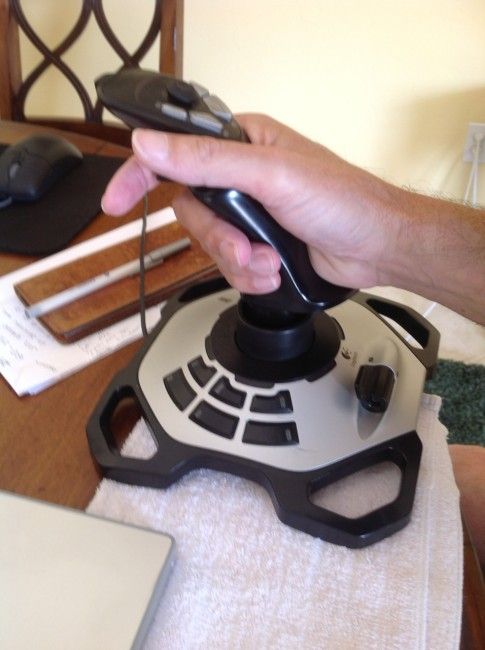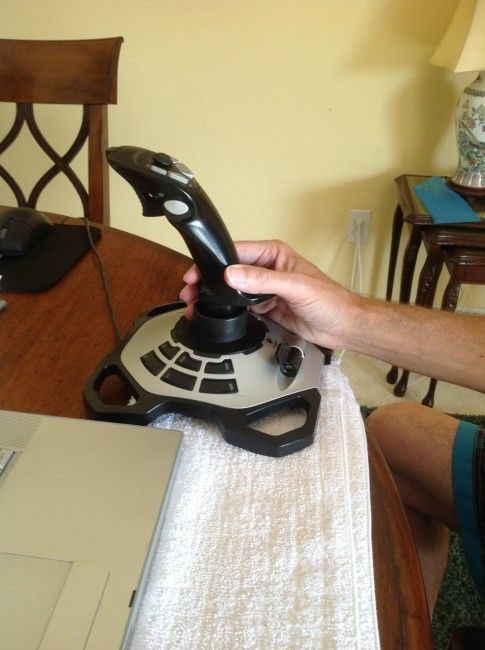Your Café editors recently received an inquiry from a Condor simulator pilot (Larry), who needed advice on how to maintain a stable position during aerotow, so we asked our Condor experts, Scott Manley and Frank Paynter, to respond to the frustrated pilot. We decided to publish Larry’s request for help and our experts’ replies in the hope it will help other Condor users.
On Thursday, February 27th, Scott will conduct two back-to-back Condor training sessions at the 2014 SSA convention in Reno, Nevada, one at 3:30 to 4:15 and the next from 4:30 to 5:15. Both will be in Room A3 in the Reno-Sparks Convention Center.
Larry: “After 20 or so launches, I can get to the start of a task about 20% of the time. The bloody thing is really touchy, even with the control sensitivity turned way down.
I am considering getting some rudder pedals.
On the good side is if I can fly this, I surely can fly our trainer.
I appreciate any help, and recommendations.”
Frank: The reason aerotow is so touchy in Condor is because it uses the European standard 100′ tow rope instead of the U.S. standard 250′ one. I guarantee you that if you tried aerotowing with your real-life glider on a 100′ tow rope, it would be just as touchy! The good news, as you pointed out, is that if you can tow successfully with a 100′ rope, then a 250′ one is ridiculously easy!
I always recommend to beginning Condor pilots that they start out with ‘Airborne’ starts (selectable at the bottom left-hand corner of the NOTAM page) until you can fly and maneuver easily – then try your hand at aerotows.
Regarding rudder pedals – they will probably make your problem worse – not better, as the physical feel of most USB rudder pedals is significantly different than real-life ones. When I instruct cross-country students in Condor, I tell them they don’t need rudder pedals if they already have a private glider license or better. OTOH, Scott Manley insists his primary gliding students use them, as they must establish the proper foot-eye-hand coordination, just as in real life.
PS: After literally thousands of Condor aerotow, I no longer even notice the difference between a 100′ tow in Condor and a 250′ one in RL. Also, I have it on good authority that Scott Manley has demonstrated aerotow in Condor – inverted! ;-).
Scott: Welcome to the wonderful world of glider flight simulation.
In addition to the issues Frank raised (100 ft rope, experience with Condor) here are some other tips.
1) There is a natural human tendency to over-control something you are unfamiliar with. Try to remember your first attempts to ride a bicycle or drive a car.
If you are new to Condor, you haven’t yet gotten used to the control response. This is why Frank and I recommend starting out your familiarization training doing airborne starts (no tow required). Get used to the control responses in free flight before having to apply them in the most demanding phase of glider flight. Unfortunately, the Condor default installation flight plan has you doing an aerotow. Most folks don’t know they have an option to start in the air.
2) Your huge are arm muscles are a poor match for the resistance in the joystick.
I use a Logitech Extreme 3D Pro. It is not a force feedback stick. It uses small springs to provide control input resistance (feel). If you grip the joystick as designed, you will naturally be using your relatively large arm muscles in opposition to some relatively small springs in the joystick. As such, you “feel” almost no resistance and naturally over-control.
I recommend resting the side of your hand on the base of the joystick and using your thumb and ring, index, and middle fingers to move the joystick. Your relatively tiny finger muscles are much more sensitive to small pressures and are a much better match for the joystick resistance. I have attached pictures of the natural vs recommended joystick grips.
3) Use your peripheral vision on tow to sense position relative to the tow plane.
If you look directly at the tow plane you are using your sharp focus vision. Your sharp focus is good for just that, sharp focus. This component of your vision is not optimized to sense motion. That is the forte of your peripheral vision.
The trick then, while on tow in Condor (and in the real world for that matter) is to focus on something other than the tow plane. My recommendation is to focus on the horizon and simply be aware of the tow plane’s position in your periphery. By using your highly-sensitive-to-motion peripheral vision, you will almost immediately sense any relative motion of your glider and the tow plane. The sooner you recognize a deviation, the more quickly you can react to it and the smaller the corrective action required.
Using your peripheral vision as primary is going to take some practice. This is likely not what you were taught to do.
Peripherally sensing out-of-position in combination your new finger tip control inputs to prevent over-controlling the glider will go a long way toward settling you down on tow in Condor.
4) Fix a deviation in pieces.
If you get out of position, please do not panic. To the best of my knowledge, no one has been killed or seriously injured by getting out of position on tow in Condor.
Step 1: Stop the deviation.
If you are moving to the right of the tow plane it is because you are banked more to the right than the tow plane. Fix that first. Bank a little left and see what happens. Do not attempt to immediately get back into position behind the tug. Just stop the deviation.
Step 2: Apply the control inputs (slowly) that will put you back into position.
For left/right deviations, your best bet is often to do almost nothing. The side pull on the tow rope has a tendency to bring you back in toward the tug.
Keep in mind your aircraft has momentum. You need to anticipate arriving back in position behind the tug and take corrective action to slow and halt your transition back to center. If you overshoot, you’re not thinking far enough in advance.
Again, you have more time than you think. There is no need to panic and over-control.
5) If things get ugly – RELEASE
If you start oscillating back and forth, off to one side, then the other of the tow plane, (and especially if the oscillations are getting larger) stop trying to recover; just release; get off tow, restart, and try it again.
My rule of thumb in Condor (and the real world for that matter) is:
If you lose sight of the tow plane for any reason (too high, too low, off the edge of the monitor left or right) you have no business staying on tow. RELEASE.
By the way, the tow plane pilot in Condor has his limits (as you likely have discovered). He is not going to let you kill him. If you get too far out of position, the Condor tug pilot will release you in a heart beat and you will be mocked with a message in the lower left hand corner of your monitor. Don’t be that guy.









4 comments for “Taming the Tow in Condor”